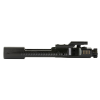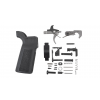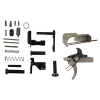The team at Brownells breaks it down and discusses the Practice of Dropping the Hammer on an AR-15 Lower. Is it good or bad?
In the world of firearms, especially among AR-15 rifle enthusiasts, there’s a constant debate about the dos and don’ts of gun maintenance. One of the more controversial topics is whether it’s harmful to drop the hammer on an empty chamber, particularly when the upper isn’t even attached to the lower receiver. While opinions vary, it’s essential to separate myths from reality and understand the practical implications of this practice.
The Common Concern: Is Dry Firing Your AR15 Rifle Harmful?
For those new to the conversation, dropping the hammer refers to pulling the trigger on your AR-15 when there’s no round in the chamber, allowing the hammer to fall without anything to strike.
Some gun owners believe this practice can cause serious damage to their firearms, while others argue it’s much ado about nothing.
To clarify, the primary worry is that the force of the hammer hitting the bolt catch can potentially transfer energy to the receiver, leading to wear and tear or even breakage over time. But how much truth is there to this concern?
Real-World Insights: Military vs. Commercial Parts
In military settings, soldiers routinely dry-fire their rifles during maintenance. Military Specification (mil-spec) components are built to endure significant abuse, and they rarely fail under such conditions. However, the AR-15 market is flooded with parts of varying quality, and not all of them meet mil-spec standards. This raises an important point: your firearm’s durability largely depends on its components’ quality.
If you’re using high-quality parts from reputable manufacturers, your AR-15 is unlikely to suffer significant damage from the occasional drop of the hammer. For example, components from companies like Sons of Liberty Gun Works or Geissele Automatics are designed to exceed mil-spec standards, providing an extra layer of reliability.


Bad Practice vs. Actual Damage
While it’s true that dropping the hammer on an empty chamber is generally considered bad practice, it’s not likely to cause catastrophic damage, especially if your AR15 rifle is equipped with high-quality components. However, it’s still advisable to avoid this practice whenever possible. As with many aspects of firearm maintenance, the goal is to minimize unnecessary stress on your equipment to ensure its longevity and reliability.
Think of it this way: Just because something won’t immediately break your firearm doesn’t mean it’s a good habit to form. It’s similar to the debate about releasing the slide on an empty chamber with a 1911 pistol.
While it might not cause immediate harm, why take the risk when it’s easy to avoid?
Final Thoughts: Quality Matters
At the end of the day, whether or not dropping the hammer on an empty chamber is a problem comes down to the quality of your components. If you’re using parts that meet or exceed mil-spec standards, your AR-15 rifle or pistol platform can handle the occasional slip-up without issue. However, it’s always better to err on the side of caution and avoid unnecessary wear on your firearm.
So, while we can agree that dropping the hammer won’t make or break your AR-15, we should also agree that it’s a practice best avoided when possible. After all, taking good care of your firearm is the key to keeping it in top condition for years to come.
Live Inventory Price Checker

|
Sons of Liberty Gun Works AR-15 5.56NATO Bolt Carrier Group | GunMag Warehouse | $ 179.99 |
|
|
|
Sons of Liberty Gun Works NOX AR-15 Flash Hider - NOX9556 | Palmetto State Armory | $ 122.99 $ 109.99 |
|

|
Sons of Liberty Gun Works Blaster Guts Lower Parts Kit - Liberty Fighting Trigger | Rainier Arms | $ 120.00 |
|

|
Sons of Liberty Gun Works Blaster Guts, Lower Parts Kit, Nitride Finish, Black | Palmetto State Armory | $ 110.00 |
|







Dropping the hammer on an AR15 lower is more damaging than when it strikes the firing pin on an empty chamber. There is a difference. Add custom springs, titanium firing pins, and different hammer kits and there are dozens of unexplored combinations which aren’t milspec and which are likely never tested. Most never will be. As for slides on 1911’s, it was common armorer practice in the day to drop them on empty chambers when clearing the weapon to rack it for storage. The next thing in the process was to pull the trigger and drop the hammer on an… Read more »
One of the tests to make sure you reassemble your M-16 properly after cleaning is a function check. 1) NO MAGAZINE and the chamber is empty, pull the charging handle back and release, put on safe and squeeze the trigger – should not “fire” 2) move from safe to fire, squeeze trigger and HOLD BACK, hammer should drop, pull charging handle and release, release trigger should hear a light click, squeeze trigger again and hammer should fall 3) Pull charging handle again move from fire to auto, squeeze trigger and hold, hammer should drop, pull charging handle and release, release… Read more »
I always catch the hammer with a finger when dry firing my lowers without the upper just to be safe and make sure I don’t cause any damage.
Someone is going to get triggered here… If you had a Rise Armament trigger, you wouldn’t need to worry. They hit so light the round doesn’t go bang. Returned that 140 and they sent me a new one with a nicely printed “sorry” card. So many bad triggers they went to the effort to make fancy cards…
I never did install the new one they sent, gave it to a buddy.
On a sidenote: I dropped the hammer last week on a job… I had to get down off the roof and get it out of the bushes.. dang it.
Dropping the hammer on a un assembled rifle and not cushioning it. is a bad idea.
Dry firing an assembled rifle is common practice.
I drop the hammer on my AR15’s, both FN and PSA-H&R, and leave the chamber empty, with a 30 round mag filled to 29 rounds in the mag well. I shoot both regularly, and keep both easily accessible around the house. Never had an issue.